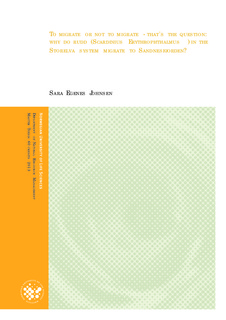| dc.contributor.author | Johnsen, Sara Egenes | |
| dc.date.accessioned | 2013-09-05T12:00:49Z | |
| dc.date.available | 2013-09-05T12:00:49Z | |
| dc.date.copyright | 2013 | |
| dc.date.issued | 2013-09-05 | |
| dc.identifier.uri | http://hdl.handle.net/11250/187053 | |
| dc.description | PIT-telemetry study about the tendency of freshwater fish to migrate to brackish water. CMR analysis to find survival probabilities under different covariates. Comparing of growth rate between migrating and non-migrating individuals and life-table simulations to estimate fitness for the two behavior options. | no_NO |
| dc.description.abstract | Migration is a common behaviour in many species and the duration and migration distance vary among species. The occurrence of migration has been related to a gain in fitness through feeding, refuge and spawning benefits, and is often a trade-off between benefits e.g. gaining high growth rate, and disadvantages, as exposure to predators.
In this study I look at the demography behind the tendency to migrate, and compare growth and survival between Storelva rudd (Scardinius erythropthalmus) that migrate to brackish water with those that do not. I test the hypothesis that migratory individuals of rudd experience higher or equal fitness than non-migratory individuals, primarily driven by growth benefits from residing in brackish waters. A total of 455 individuals were PIT-tagged. Capture-Mark-Recapture-analysis was used to find their survival probabilities and between-habitat migration probabilities under different period-specific and individual-specific covariates. Individual growth rates were compared between the two groups and I used life-table simulations to estimate fitness for the different behaviour options.
The freshwater rudd grew slightly better and growth rate was positively correlated to temperature. Migration to brackish water was driven by river discharge and migration to freshwater by fjord salinity. Survival in brackish water was affected by salinity and fish length and survival in freshwater by water discharge and temperature. Rudd smaller than 12-13 cm had very low survival rates in brackish water. Population mean fitness was lower in migratory individuals than for the freshwater residents. The ultimate prediction from my study is that the migratory genotypes over time will vanish from the population. I discuss short-comings in the fitness estimates and that the estimates are premature owing to a short study period and lack of information about the maturation pattern. Since the migrants experience no growth-related benefits from migrating into the brackish-water habitat, I suggest that density-dependent factors in the freshwater habitat comprise the main driver of this migration system. In particular, I suggest that the high pike density in Lundevann may motivate the migrants to seek lower predation-pressure in the freshwater habitat. The rudd migrants constitute a threat to spreading of rudd along the coast and into new water courses. There might be two subpopulation types and they should be managed accordingly.
In conclusion, the driving forces behind rudd migration in the Storelva system remains enigmatic and continuation of the PIT-tag study should be secured. | no_NO |
| dc.language.iso | eng | no_NO |
| dc.publisher | Norwegian University of Life Sciences, Ås | |
| dc.subject | rudd | no_NO |
| dc.subject | scardinius erythrophthalmus | no_NO |
| dc.subject | migration | no_NO |
| dc.subject | brackish water | no_NO |
| dc.subject | PIT-telemetry | no_NO |
| dc.subject | CMR-analysis | no_NO |
| dc.subject | growth rate | no_NO |
| dc.subject | fitness | no_NO |
| dc.subject | predation | no_NO |
| dc.title | To migrate or not to migrate - that`s the question : why do rudd (Scardinius erythrophthalmus) in the Storelva system migrate to Sandnesfjorden? | no_NO |
| dc.type | Master thesis | no_NO |
| dc.subject.nsi | VDP::Mathematics and natural science: 400::Zoology and botany: 480::Ecology: 488 | no_NO |
| dc.subject.nsi | VDP::Mathematics and natural science: 400::Zoology and botany: 480 | no_NO |
| dc.source.pagenumber | 59 | no_NO |
